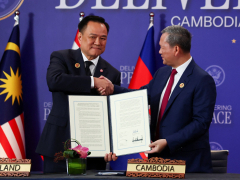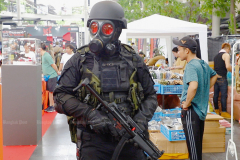United States President Donald Trump has kicked off his weeklong, high-stakes diplomatic tour of Asia in the Malaysian capital, Kuala Lumpur, by presiding over the signing of a peace declaration between Thailand and Cambodia.
Trump had flown to Malaysia to attend the summit of the Association of Southeast Asian Nations (ASEAN), where he also signed separate trade deals on Sunday with Cambodia, Thailand and Malaysia as well as agreements on critical minerals with Bangkok and Kuala Lumpur.
The highlight of his appearance was a peace declaration between Cambodia and Thailand that expanded on a ceasefire agreement reached in July, which brought deadly border clashes to a halt.
The agreement was signed by the prime ministers of the ASEAN neighbours, Thai Prime Minister Anutin Charnvirakul and Cambodian Prime Minister Hun Manet, and was overseen by Prime Minister Anwar Ibrahim of Malaysia, which currently chairs ASEAN.
While the regional leaders hailed the ceasefire as “historic”, the differences between them run deep with decades-long disputes over their border and temples claimed by both sides.
So what’s in the deal and can the ceasefire really hold?

What do we know about the peace agreement?
Under the joint declaration by the leaders of Thailand and Cambodia signed on Sunday, the neighbours pledged “unwavering commitment to peace and security” and committed to an immediate halt to hostilities, reaffirming their earlier July pledge to avoid the use of force and respect each other’s sovereignty and territorial integrity.
The Kuala Lumpur Peace Accord, as Trump named it, marks the most detailed attempt yet to end fighting between Thailand and Cambodia along their disputed border.
At the core of the deal is a plan for military de-escalation under ASEAN members’ supervision. Both sides agreed to remove heavy weapons from border areas and return them to regular bases with verification by a new ASEAN Observer Team (AOT).
Beyond military measures, the agreement also addressed an “information war” that has emerged in recent months and fuelled tensions in both countries. Bangkok and Phnom Penh pledged to refrain from spreading false or inflammatory claims through official or unofficial channels.
Both governments have committed to resume normal diplomatic engagement and coordinate local-level talks through established mechanisms like the General Border Committee and the Joint Boundary Commission.
The two countries also pledged to coordinate and implement humanitarian de-mining in the border areas, one of the key triggers behind the recent round of fighting.
Upon fulfilment, Thailand has undertaken to release 18 Cambodian soldiers captured during this year’s fighting.

How has each side reacted?
Anutin said Bangkok stands for peace and “this declaration, if fully implemented, will create the building blocks for a lasting peace.”
Hun Manet called the signing of the joint declaration a “historic day”.
“It will begin the process of mending our ties,” Anutin said, adding that “innocent civilians have suffered immense losses.”
Anwar said the agreement “reminds us that reconciliation is not concession but an act of courage”.
Trump spoke the longest of all.
Sitting at the table with the regional leaders in front of a backdrop covered with the words “Delivering Peace”, Trump said: “Everybody was sort of amazed that we got [the ceasefire] done so quickly.”
“My administration immediately began working to prevent the conflict from escalating,” he added, recalling how he had learned of the fighting while visiting his Turnberry golf course in Scotland in July.
“I said this is much more important than a round of golf,” Trump said, adding, “I could have had a lot of fun, but this is much more fun, … saving people and saving countries.”
“The eight wars that my administration has ended in eight months – there’s never been anything like that,” Trump boasted. “It’s like, I shouldn’t say it’s a hobby, because it’s so much more serious, but something I’m good at and something I love to do.”

What was the fighting about?
Relations between Thailand and Cambodia have been at their worst in decades.
The 800km-long (nearly 500-mile-long) border between the Southeast Asian neighbours has long been a source of conflict. Both sides dispute demarcations drawn in 1907 during French colonial rule in Cambodia.
The border areas are replete with centuries-old temples, some of which are claimed by both sides. The disputed regions are also home to communities on both sides of the border who share ancestry and heritage.
In February, a dispute over Prasat Ta Moan Thon, a Khmer temple, flared up after Thai police reportedly stopped Cambodian tourists from singing





